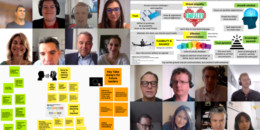‘What are the main challenges senior leaders face during the pandemic, what leadership skills have they developed to address these, and which skills do they think future leaders will need if this becomes the new normal?’ This was the task which faced participants in a unique online workshop in mid-July this year.
Six weeks earlier at the second quarterly meeting of the EIIL’s ‘Leadership Development Board’ (LDB), a working group of the senior talent development professionals from our member companies, had discussed the impact the COVID19 pandemic was having on their companies.
With just over two month’s experience of working from their home offices, all recognised that things were beginning to change, possibly forever. New skills, and different applications of familiar skills, were clearly needed for the post-pandemic workplace, but which of these were most necessary to incorporate into the development plans of our members’ future leaders? In two teams, supported by alumni from the EIIL Talent Team programme, the LDB set out to answer this question.
Over two days they prepared and conducted (video-call) interviews with four senior industry leaders from the EIIL network, reviewed these, and produced their own ‘one-page info-graphic’ reports as their workshop output. This article, and those following, summarise highlights from the EIIL team’s own analysis of these interviews.
In the sectors of the EIIL’s current members, chemicals & plastics, industrial gases, energy and the EPC contractors who build their plants, business has continued with limited pandemic impact. Even in lockdown the markets still need what these industry sectors make. Expectation-setting communications with customers about confinement measures and how these would impact them seems to have stabilised initial concerns.
Those designing and building new assets for the sector have noticed traditional, cautious client companies postpone investments, but this has hastened their planned transitions to a greener client focus where projects are still being tendered.
Despite rapidly-deployed short term cost-reduction measures (e.g. 20% salary cuts in exchange for additional holidays or reduced working hours) and the consequent reduced capacity for work, productivity reportedly went up.
Technology has allowed everyone to be more accessible. Travel restrictions have made all, and particularly the most senior leaders, more available. Air time with the Executive Committee has increased.
Remote commissioning has been demonstrated as being possible, after years of argument to the contrary, so quicker contributions from experts and reduced project schedules are now expected.
More generally, higher productivity was reported as a result of fewer distractions (own space vs shared office space) and also of distributed teams local, regional and global, putting in additional effort to connect more, bringing them closer together. Video-conference has become a great equaliser; removing the ‘second class’ status of those formerly joining physical team meetings by VC as the exception.
The biggest challenge faced by our interviewees was not being able to ‘feel the pulse’ of their organisation. They had all worked on solutions to ‘be more available’ and to ‘keep up quality contacts’ (virtual coffee meetings, drop-in hangouts, ‘no agenda’ meetings) , but were generally unsatisfied that these were providing the necessary informaility, spontaneity, information flow and ‘feel’.
They also reported worrying that others in the hierarchy might not be able to create and maintain the high-trust culture necessary for working from home office. Providing support for those less comfortable with remote working was a high priority (‘this is an extreme form of multi-office project execution (MOPEX), and we know who already struggles with MOPEX’).
Hardest of all challenges was creating new relationships, particularly external ones. Meeting new clients and building trust in personal relationships ‘is different without dinner etc.’ but ‘everyone is in the same boat, clients too’. Recognised as requiring more discipline and more scheduling, nevertheless our leaders all appeared to relish, and to have enjoyed rising to, this particular challenge.
However, building relationships with new colleagues, including onboarding new people, also requires a similar discipline, and scheduling of time and attention, as does maintaining existing relationships. Finding a solution to provide the time and attention to inform, guide and motivate the wider organisation (‘spreading the love’) was reportedly much more difficult.
One EPC contractor lamented ‘the biggest miss is ‘corridor engineering’ – young people may be shy to message experts’. To maintain and develop technical networks, the know-who essential to ensure that corporate know-how circulates effectively, requires particular attention. Especially when corridors and coffee machines are virtual, and the only encounter on your walk for a bio break is your dog.
Most of the fears our leaders had before lock-down about home office working have proven unfounded. Their people have adapted really well and shown that it can work.
The technology sometimes fails, though this gives a common relationship-building experience, and also helps further develop the increased tolerance gained from the unavoidable domestic interruptions.
The new normal has seen productivity increases across the sector as well as personal / domestic benefits for a large proportion of the company. Our leaders believe it to be ‘unlikely’ that their companies will ever work again in the old style. Even amongst the most connected, home office flexibility was well overdue.
There are some for whom confinement has been a big challenge and these could be expected to want to return to the office as soon as possible, but for others there really does need to be a compelling reason. With social distancing measures companies have reduced their office capacity and introduced rotation patterns to ensure all (or all who want to) are able to attend. Some companies have taken the opportunity to reduce their real estate commitments and further reduce capacity.
Post-pandemic, when social distancing measures are eventually relaxed and office space becomes more available, companies will need to redefine what the office is for; to answer why, as well as how often, their employees must go there.
……. Our next article in this series will look at the Tasking and Trusting skills our leaders have demonstrated to address these challenges.

